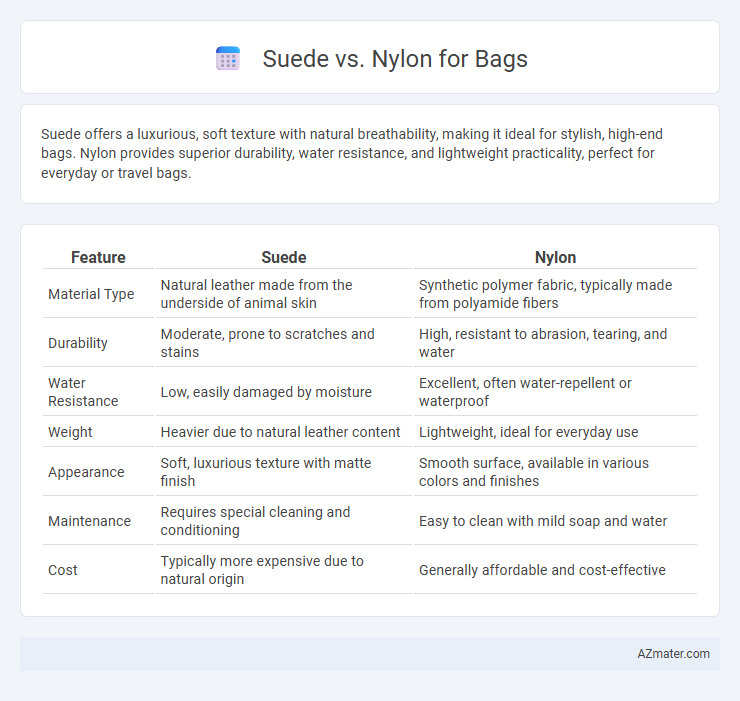Suede offers a luxurious, soft texture with natural breathability, making it ideal for stylish, high-end bags. Nylon provides superior durability, water resistance, and lightweight practicality, perfect for everyday or travel bags.
Table of Comparison
| Feature | Suede | Nylon |
|---|---|---|
| Material Type | Natural leather made from the underside of animal skin | Synthetic polymer fabric, typically made from polyamide fibers |
| Durability | Moderate, prone to scratches and stains | High, resistant to abrasion, tearing, and water |
| Water Resistance | Low, easily damaged by moisture | Excellent, often water-repellent or waterproof |
| Weight | Heavier due to natural leather content | Lightweight, ideal for everyday use |
| Appearance | Soft, luxurious texture with matte finish | Smooth surface, available in various colors and finishes |
| Maintenance | Requires special cleaning and conditioning | Easy to clean with mild soap and water |
| Cost | Typically more expensive due to natural origin | Generally affordable and cost-effective |
Introduction: Suede vs Nylon Bags
Suede bags offer a luxurious, soft texture and a rich aesthetic that enhances fashion-forward styles, while nylon bags excel in durability, water resistance, and lightweight convenience, making them ideal for everyday use. The choice between suede and nylon hinges on prioritizing elegance and texture versus practicality and resilience. Understanding the material characteristics of suede and nylon helps consumers select bags suited for different lifestyles and environments.
Material Overview: What is Suede?
Suede is a type of leather made from the underside of animal hides, primarily from lamb, goat, or calf, characterized by its soft, napped finish and velvety texture. Unlike nylon, suede offers a natural, breathable material that provides a luxurious look and feel but requires careful maintenance to prevent stains and water damage. This material is favored in bag design for its aesthetic appeal and unique tactile experience, making it a premium choice for fashion-forward consumers.
Material Overview: What is Nylon?
Nylon is a synthetic polymer known for its durability, water resistance, and lightweight properties, making it an ideal material for bags subjected to heavy use and weather exposure. Its high tensile strength and abrasion resistance contribute to long-lasting performance, while its smooth texture allows for easy cleaning and maintenance. Often used in outdoor and travel bags, nylon offers superior functionality compared to natural materials like suede.
Durability Comparison: Suede vs Nylon
Nylon offers superior durability compared to suede, featuring high resistance to abrasion, moisture, and tearing, making it ideal for heavy-duty bags and outdoor use. Suede, while luxurious and soft to touch, is more prone to wear, staining, and water damage, requiring special care to maintain its appearance and longevity. For long-lasting performance, especially in rugged conditions, nylon bags outlast suede alternatives by a significant margin.
Style and Aesthetics: Suede Bags vs Nylon Bags
Suede bags exude a luxurious, soft texture with a rich, matte finish that adds sophistication and warmth to any outfit, making them ideal for elegant, classic styles. Nylon bags offer a sleek, modern look with a smooth, slightly shiny surface that complements casual and sporty aesthetics, enhancing durability without compromising style. The choice between suede and nylon bags depends on whether the desired look leans towards timeless elegance or functional, contemporary chic.
Weight and Comfort: Which Feels Better?
Suede bags offer a soft, luxurious texture that feels comfortable against the skin but tend to be heavier due to the dense leather fibers. Nylon bags are significantly lighter, making them ideal for extended carrying without fatigue, and their smooth synthetic fibers provide a flexible, breathable feel. When prioritizing weight and comfort, nylon generally feels better for everyday use, while suede appeals to those valuing tactile softness despite added heft.
Maintenance and Cleaning: Suede vs Nylon
Suede requires delicate maintenance, necessitating special brushes, suede erasers, and water-repellent sprays to prevent stains and damage, while nylon offers easy cleaning with just soap, water, and a soft cloth. Unlike nylon, suede is prone to water damage and stains, demanding more frequent and careful upkeep to maintain its texture and appearance. Nylon's durability and resistance to dirt make it ideal for low-maintenance bags that retain cleanliness with minimal effort.
Weather Resistance and Versatility
Suede offers a luxurious texture but is less weather-resistant, often absorbing water and staining easily, making it less suitable for wet or harsh conditions. Nylon excels in weather resistance due to its water-repellent properties and durability, making it ideal for all-weather use and outdoor activities. Nylon's lightweight and versatile nature also allow for a wide range of bag styles, from casual to sporty, whereas suede is typically reserved for fashion-forward, indoor use.
Price and Accessibility
Suede bags generally come at a higher price point due to the cost of genuine leather and the complex manufacturing process, making them less accessible to budget-conscious buyers. Nylon bags are more affordable and widely available, thanks to the synthetic material's low production cost and mass-market popularity. As a result, nylon offers better accessibility in terms of price and availability, appealing to a broader range of consumers.
Which Bag Material is Right for You?
Suede offers a luxurious, soft texture with a distinctive matte finish, ideal for stylish bags that prioritize aesthetics and a premium feel. Nylon is lightweight, durable, and water-resistant, making it perfect for everyday use and bags requiring high functionality and weather resistance. Choosing between suede and nylon depends on whether you value fashion-forward elegance or practical durability in your bag material.

Infographic: Suede vs Nylon for Bag
 azmater.com
azmater.com